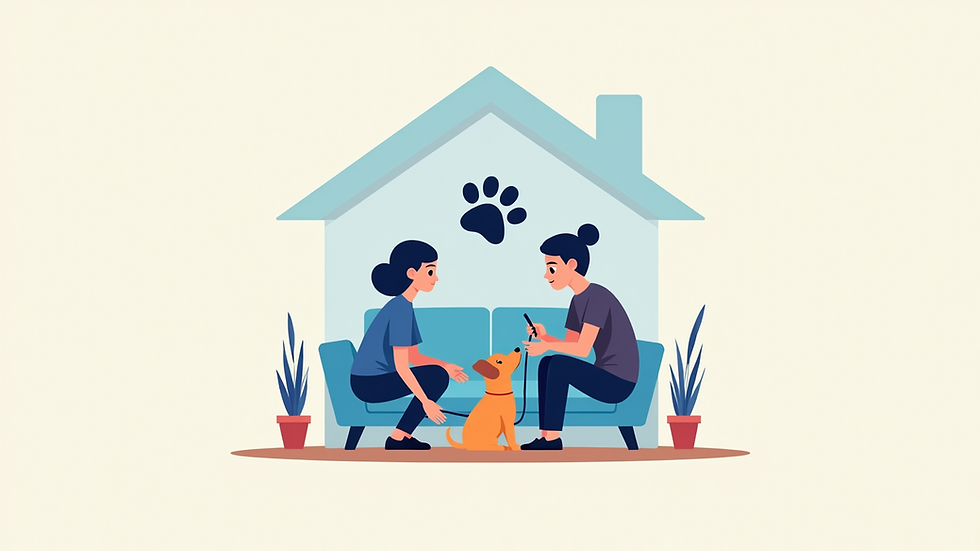
Preparing Your Home and Pets for a Pet Sitter: A Stress-Free Guide
- Donte B.
- Feb 28
- 3 min read
Preparing Your Home and Pets for a Pet Sitter: A Stress-Free Guide
Planning a vacation should be exciting, not stressful. But if you're a pet owner, leaving your furry, feathered, or scaled companions behind can add a layer of complexity. Ensuring their well-being and your peace of mind requires careful preparation, especially when entrusting their care to a pet sitter. Whether you're a first-time pet owner or a seasoned traveler, this guide will help you navigate the process smoothly.
Finding and Screening the Right Pet Sitter
The first step to a successful pet-sitting experience is finding a reliable and trustworthy sitter. Here's how:
Ask for Recommendations: Start by asking friends, family, neighbors, or your veterinarian for recommendations. Personal referrals can provide valuable insights into a sitter's reliability and experience.
Online Platforms: Utilize reputable online platforms like Rover, TrustedHousesitters, or local pet-sitting services. These platforms often include sitter profiles, reviews, and background checks.
Interviews and Meet-and-Greets: Schedule interviews and meet-and-greets before finalizing your decision. Observe how the sitter interacts with your pet and ask relevant questions:
What experience do they have with your pet's breed or species?
Are they certified in pet first aid and CPR?
Can they provide references?
What is their availability and flexibility?
Background Checks and References: Don't hesitate to request background checks and contact references. A thorough screening process ensures your pet's safety and your peace of mind.
Trial Run: If possible, consider a short trial run before your actual trip. This allows your pet to get acquainted with the sitter and helps you assess their compatibility.
Preparing Your Home for the Pet Sitter
Creating a comfortable and organized environment for your pet sitter is essential. Here's what to prepare:
Pet Care Information:
Detailed feeding instructions, including portion sizes and feeding times.
Medication schedules and administration instructions.
Emergency contact information, including your veterinarian's details.
A list of your pet's habits, preferences, and any behavioral quirks.
Walking routes, playtime routines, and any specific commands.
Pet Supplies:
An ample supply of pet food, treats, and medications.
Leashes, collars, harnesses, and any necessary walking gear.
Litter boxes, waste bags, and cleaning supplies.
Toys, bedding, and comfort items to make your pet feel at ease.
Home Essentials:
Clear instructions for operating appliances, security systems, and any other relevant household features.
A designated space for the sitter to store their belongings.
Information on local emergency services and contact details for trusted neighbors.
Wifi access and passwords.
Clean and Organize: Before leaving, ensure your home is clean and organized. This creates a welcoming environment and helps the sitter locate essential items.
Pet Care Guidelines and Communication
Clear communication and established guidelines are crucial for a successful pet-sitting experience:
Daily Routine: Provide a detailed schedule of your pet's daily routine, including feeding, walking, playtime, and any other activities.
Emergency Procedures: Outline clear emergency procedures, including contact information for your veterinarian and instructions for handling unexpected situations.
Communication Schedule: Establish a communication schedule, such as daily updates or photos, to stay informed about your pet's well-being.
House Rules: Clearly communicate any house rules, such as designated pet areas, restrictions on certain rooms, or any other relevant guidelines.
Special Needs: If your pet has special needs, such as medical conditions or behavioral issues, provide detailed instructions and address any concerns with the sitter.
Return Instructions: Give clear instructions for the end of the petsitting assignment. Include any cleaning instructions, and when and how to return keys.
Creating a Pet-Friendly Environment
Safety First: Ensure your home is pet-proofed, removing any potential hazards, such as toxic plants, exposed wires, or small objects that could be swallowed.
Comfort Zone: Create a comfortable and safe space for your pet, with access to their favorite toys, bedding, and hiding spots.
Temperature Control: Maintain a comfortable temperature in your home, especially during extreme weather conditions.
Security: Ensure all doors and windows are securely closed to prevent your pet from escaping.
Post-Trip Follow-Up
Feedback: After your trip, provide feedback to the pet sitter, both positive and constructive, to help them improve their services.
Gratitude: Express your gratitude for their care and consider leaving a tip or a small gift.
Review: If you used an online platform, leave a review to help other pet owners find reliable sitters.
By following these guidelines, you can ensure a stress-free vacation while providing your beloved pets with the best possible care. Remember, preparation and communication are key to a successful pet-sitting experience.







Comments